



© David Hallam 1988 - 2006
|
Black & Gold - the Story of 2nd Beeston Sea Scouts - continued
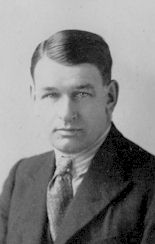 Out of the Harbour (November 1932 - August 1939) - When the 2nd Beeston was first formed, it had been decided by the then Vicar (Fr. Phillips), that the Curate of the day should automatically become the
Group Scout Master. This decision provided the Group with some wise and excellent leadership in these early days. In this way, Fr. Otway's replacement
as Curate, Rev. Arthur Rumball (Pictured left) took up the position on his arrival in Beeston. He was appointed in November 1932 and arrived before Christmas that year.
Fr. Rumball ('Skipper' to the members) came from Attleborough in Norfolk where he had been involved in Scouting so was an excellent choice as
far as 2nd Beeston was concerned. It seems likely that, when choosing the Curate, his scouting experience was an important consideration.
Out of the Harbour (November 1932 - August 1939) - When the 2nd Beeston was first formed, it had been decided by the then Vicar (Fr. Phillips), that the Curate of the day should automatically become the
Group Scout Master. This decision provided the Group with some wise and excellent leadership in these early days. In this way, Fr. Otway's replacement
as Curate, Rev. Arthur Rumball (Pictured left) took up the position on his arrival in Beeston. He was appointed in November 1932 and arrived before Christmas that year.
Fr. Rumball ('Skipper' to the members) came from Attleborough in Norfolk where he had been involved in Scouting so was an excellent choice as
far as 2nd Beeston was concerned. It seems likely that, when choosing the Curate, his scouting experience was an important consideration.
About the time of the changeover, it was noted that the Group had a small financial deficit of about £5 and it was considered by all that this should
be cleared in honour of Fr. Otway’s work and to leave the decks clear for his successor. It was decided to hold a Sea Scout Social at the end of November
and it was particularly significant that, apparently for the first time, this was organised by a group of 'Friends of the Group', so beginning
a long tradition of support by groups of parents and friends. The social was a huge success with nearly 200 scouts, families and friends attending. The
organising committee had as its secretary, Miss Dorothy Woods.
It appears that, in addition to his undoubted skill as a Scouter, Father Rumball had the ability to organise and direct concerts by the members of the
Group. At about that time, there was a need to raise money to support other Groups in the Beeston area which were beginning to get established - the
British Legion Group (the '3rd') - formed about April 1932, and the 4th Beeston ('Lenton Abbey') - formed in November 1932. The more established
Groups, 1st and 2nd Beeston together with the Chilwell & Attenborough and the Stapleford & Sandiacre Groups - each of which had been established some
years - put on a 'Scouts Non-Stop Variety Show', a 'Concert Jamboree' to raise the money. Busy behind the scenes, rnarshelling the performers, were the
new ASMs Hall and Newbold and there was a piano duet from Arthur Smedley and Fred Robinson, a recitation from Len Richmond and Fred Thraves and sketches
from other members of the Group. More badges were awarded and Father Rumball received his Scoutmaster's Warrant.
It was around this time that the Group added a Cub Pack to cater for the growing demand from younger boys of the Church - it gained 18 members in its first
year and quickly rivaled the Scouts in number but most of all would prove invaluable in supplying a steady stream of recruits for the Troop who were
already trained in the elements of Scouting. The first Cubmaster was Joe Hall who received his warrant in December 1933 assisted by Norman Spicer who
obtained his warrant in January 1934.
Easter 1933 found the lads once more at the River Base ('Frobisher' as it was known to the members ) - but this time there was a difference.
Col. Jardine had, from the start, made the site available, for the joint use of the 1st and 2nd Beeston, free of charge. Now the 1st Beeston had faded
away and the 2nd had been granted Its sole use. This new opportunity naturally entailed increased responsibility and expense. As a response, the Parents'
Committee organised a successful dance at Station Road Schools attended by 200.
Many years after the formation and demise of the 1st Beeston Group, the feeling arose amongst some members of 2nd Beeston that their claim on the '1st'
designation was somewhat tenuous. There were no Beeston boys in that Group, their Town Headquarters was in Nottingham and the River Base, although on
the Beeston Reach of the River, was in Clifton Parish. Similar feelings are held about the 1st Notts Sea Scouts, formed, by Don Stocker, about the same
time as the demise of the 1st Beeston. Although set up on Barton Island (the South-Western end) it drew its members from Nottingham and had land headquarters
there. The use of 'Notts' was therefore curious and in fact unusual. This Group later became the 100th Nottingham.
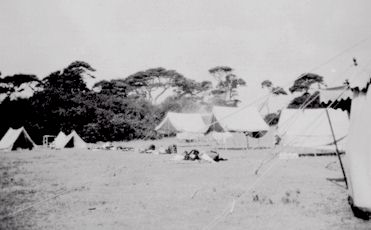 In August came the Summer Camp - this time at Oulton Broad near Lowestoft. (Click the picture on the left for more) Father Rumball no doubt had some influence in the choice of this venue using
contacts from his former Parish. Support from friends of the Group was again in evidence - the boys paid a nominal charge and the rest was made up be
fund-raising and from gifts of food.
In August came the Summer Camp - this time at Oulton Broad near Lowestoft. (Click the picture on the left for more) Father Rumball no doubt had some influence in the choice of this venue using
contacts from his former Parish. Support from friends of the Group was again in evidence - the boys paid a nominal charge and the rest was made up be
fund-raising and from gifts of food.
1934 started with another significant milestone in the Group's history - the formal creation of a Rover Crew. The adult helpers had been designated as
‘Rovers’ for some years but now they were to be formalised. The early Crew consisted of Joe Hall, Bernard Highton, Disney Keeble, Len Richmond, Fred
Robinson, Arthur Smedley and Norman Spicer. By the end of the Thirties, these had been joined by Geoff Pickering, A. Rowland, Edward and George Smedley
and Doug and Fred Thraves. It was Father Rumball's intention from the start to give real meaning to becoming a Rover. He involved two of his contacts
from Attleborough, Harry Cole and John Clarke as Sponsors and devised a form of Initiation prior to Rover investiture. This consisted of a period of
vigil in the Parish Church and an exercise in Self Examination designed to guide the applicant to a life of purpose and service. Applicants preparing
for full membership of the Crew were known as Rover Squires. There is no doubt that this preparation had a lasting effect for good on those who had the
privilege to take part and such preparation was continued In Canon Halet's period as Vicar, up to the end of the Fifties.
2nd Beeston involvement in Church Social occasions stayed much in evidence. In February 1934. three of the Rovers, Spicer, Richmond and Keeble gave 'an
amusing turn' at a Church Concert and, in May that year, many familiar 2nd Beeston names appeared in a Beeston Parish Church Minstrel Troop which enjoyed
a long running popularity.
New starters by 1934 included William Davidson, S. Davis, John Gibson, Arthur Hayter, Dennis Hudston, William Lovell, Geof Pickering, Dennis Roberts
and Hedley Versey. The Group also gained a trio of 'civilian' instructors at that time - Mrs Eden (Arts and Crafts), Mr H Densham (Ambulance) and Mr E. J.
Searle (Physical Training).
At Whitsuntide 1934, Skipper Rumball and eight scouts and rovers attended a Jamboree at Costessey Park, Norfolk where they camped jointly with the 1st
Attleborough and the 2nd Wymondham troops. On the way there, Father Rumball - a Cambridge MA. himself - showed the boys around the sights of Cambridge
including, of course, Kings College Chapel. Over the weekend they managed to fit in a visit to Norwich between the organised events which included two
Camp-fires, a Scouts Own Service and an official visit from the Duke of Gloucester. On the Tuesday they left, moving to East Harling for two nights,
where they fitted in a visit to Walsingham.
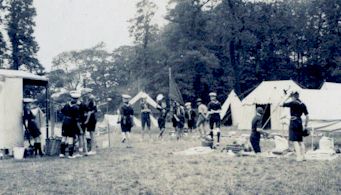 The Annual Camp in 1934 was held at Gilwell Park. Getting to Gilwell involved going through London - a new experience for most of the members. Skipper,
with Jim Utting and Bernard Highton, traveled separately by car (an Austin 12) with much of the kit whilst the majority of the party went by train
under the command of Joe Hall and Disney Keeble. After a somewhat eventful journey with some confusion about the arrangements at London, and a boisterous
group of lads causing much mischief on the way - imagine the Underground journey ! - they arrived late but safely after an eight hour journey. Once
again, they were joined by a contingent from Norfolk. During the week, there were visits to London - the first time there for many of the lads - with
trips on the Thames, amongst other local outings, meetings with scouts of many Nations and a most memorable Camp-fire. (Click the image on the left to see
more scenes from this camp.)
The Annual Camp in 1934 was held at Gilwell Park. Getting to Gilwell involved going through London - a new experience for most of the members. Skipper,
with Jim Utting and Bernard Highton, traveled separately by car (an Austin 12) with much of the kit whilst the majority of the party went by train
under the command of Joe Hall and Disney Keeble. After a somewhat eventful journey with some confusion about the arrangements at London, and a boisterous
group of lads causing much mischief on the way - imagine the Underground journey ! - they arrived late but safely after an eight hour journey. Once
again, they were joined by a contingent from Norfolk. During the week, there were visits to London - the first time there for many of the lads - with
trips on the Thames, amongst other local outings, meetings with scouts of many Nations and a most memorable Camp-fire. (Click the image on the left to see
more scenes from this camp.)
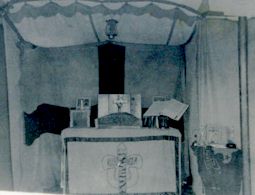 It was for this camp at Gilwell that Father Rumball had an alteration made to the small marquee - part of the original equipment but a familiar 'land-mark' at
camps well into the 50s. He had an annexe added to the rear wall so that it could accommodate an altar (See right). Holy Communion was celebrated daily during the
camp.
It was for this camp at Gilwell that Father Rumball had an alteration made to the small marquee - part of the original equipment but a familiar 'land-mark' at
camps well into the 50s. He had an annexe added to the rear wall so that it could accommodate an altar (See right). Holy Communion was celebrated daily during the
camp.
As we have seen, the Group used Station Road Schools on the East side of Station Road, Beeston for their land Headquarters in the early days. Now, with
the Cub and Rover Sections fully operational, there was a greater need than ever for space. By early 1935, the old National Schools, owned by the Church,
on the opposite side of the road became available and they were able to transfer their meeting place and changes could be made to enable the Group to
have a place to call 'their own' and to operate more efficiently. The large hall at the South end of the building was partitioned off for each Patrol
and a 'Den' for the cubs. The Scoutmaster had a room and there was a side room for the Rovers. No doubt, these changes were once again the handiwork of
Joe Hall and the rovers. The northern end of the building was separately occupied by the Youth Fellowship. The new facilities were Opened at the end of
February 1935 by County Commissioner Lancelot Allen supported by ADC W Macrow. Father Rumball, the GSM led the rovers, scouts and cubs in a programme
of entertainment. Each Patrol - now with the names which are in use up to today, 'Evans', 'Sturdee' and 'Jellicoe', later
to be joined by 'Benbow' - each performed a 'turn' as did the Rovers and the Cub Sixers. The evening was closed with a programme of songs with
all present participating.
In March 1935, it was the turn of Father Rumball to leave. He too had served the Group well - like Father Otway, for just over three years - and at a
Farewell Supper, held at the Group Headquarters, ASM Arthur Smedley paid tribute to him and presented a bronze statuette of a scout on behalf of the
Rovers, Scouts and Cubs. On that occasion, also, a silver pencil case was presented to Scout Davidson who was also leaving Beeston. The evening was
rounded off with the customary Camp-fire.
Four months later, the London Evening News reported a new exploit of Father Rumball. With a, colleague, he had crossed the desert between Nigeria and
Aswan and then via Suez to Jerusalem by private car despite warnings from the authorities regarding the hazards of the venture following the deaths,
the previous month, there of four French Colonial Service officials. They then made their way back to London via Constantinople.
Travelling by car was something that Father Rumball always did in style. Whilst in Beeston he owned a large, eight cylinder Cadillac. Whilst nominally
a two seater with a dickey seat, the record for its passengers was 17 scouts on a journey from Beeston to Nottingham !
Continuing the tradition of appointing the Curate of the day to lead the Group, the Rev J. Lee, who had arrived from Battle in Sussex in April 1935,
became the new GSM. He had had an active interest in Scouting and was ADC in Battle. This time, however, there was a difference in that at the same
time, Arthur Smedley took on the onerous task of Scoutmaster, receiving his warrant in July 1935.
(A group photograph taken at this time can be seen by clicking here)
That Spring found the Scouts back at the River Base which they had improved in various ways since taking up sole occupation. Now they were collecting
plants to add further to its appearance. Summer camp, Wakes week,1935 was held at
Withernsea on the Yorkshire Coast but before that the whole troop was inspected
in June by Col John Jardine. In his address to the Troop he was unstinting in his praise:
The greatest credit is due to everyone concerned and I am proud to be associated with such a Troop. The turnout, the discipline, and the
system of instruction were all excellent. The Troop is fortunate to have such a good and permanent club room and it has been admirably fitted up. The
different cubicles for the patrols and cubs is an admirable idea. I think very highly of the capabilities of Acting SM A.W. Smedley and he is loyally
and ably assisted by ASH J Hall. A fine lot of lads, and keen and efficient P/Ls, well looked after by Troop Leader G. D. Smedley. You certainly have
a troop that you can be proud of and which could be put up as a specimen of what a.Troop should and can be. I hope to see more of it this year.
A newcomer to the Troop’s numbers, was Steve O’Donoghue who 'came-up' from the cubs in June 1935. He appears to have been the first member to make this
transition.
Towards the end of 1935, Rev. Norman Phillips, who had been Vicar for over 11 years at Beeston and, as we have seen, was one of those primarily involved
in the formation of the Group, left to take up a living at St Nicholas, Brighton. His replacement was Rev George Hansford who was previously at New Berry,
Farnworth, and who was inducted at Beeston in February 1936. Two months later, in April 1936, Father Lee, the Curate and GSM also left to be replaced by
Rev Frank Atherton Addison, formerly Curate of All Saints, Bradford. Following the rule laid down by Father Phillips, the new Curate became the new GSM.
By 1939, the Vicar, Father Hansford, decided that the Curate of a Parish the size of Beeston had too much to do in connection with his normal Church
activities to enable him to run the Sea Scout Group effectively. Arthur Smedley thus became the first lay Group Scout Master with Joe Hall as Scoutmaster
and Bernard Highton as ASM - a post he had held since March 1936.
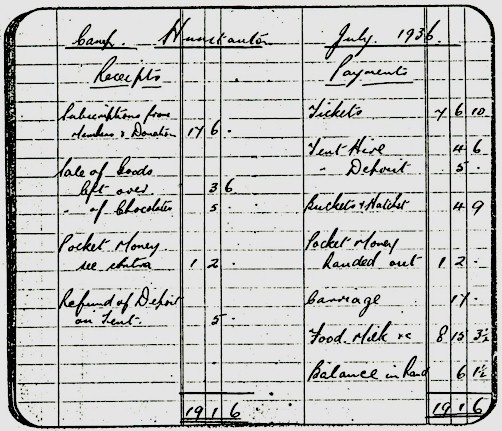 Meanwhile, in Summer 1936, the Annual Camp was held at Old Hunstanton Hall in Norfolk. There were 14 scouts, rovers and officers in camp and Bernard Highton
carried out what became a traditional role as Quartermaster. His accounts show the younger lads paid fifteen shillings (75p), the older ones £l.5s (£l.25)
and the Officers and Rovers £l l0s (£l.50). A scout’s typical pocket money was 5 shillings (25p). The total paid by those attending was approximately
£17, £7 was spend on rail tickets, £9 on food and about a £1 on sundries, the camp finished with a surplus of about 6 shillings (30p). (Click the image
on the right to see Bernard's meticulous balance sheet and some scenes from this camp.)
Meanwhile, in Summer 1936, the Annual Camp was held at Old Hunstanton Hall in Norfolk. There were 14 scouts, rovers and officers in camp and Bernard Highton
carried out what became a traditional role as Quartermaster. His accounts show the younger lads paid fifteen shillings (75p), the older ones £l.5s (£l.25)
and the Officers and Rovers £l l0s (£l.50). A scout’s typical pocket money was 5 shillings (25p). The total paid by those attending was approximately
£17, £7 was spend on rail tickets, £9 on food and about a £1 on sundries, the camp finished with a surplus of about 6 shillings (30p). (Click the image
on the right to see Bernard's meticulous balance sheet and some scenes from this camp.)
In 1937, membership numbers in the Scout section declined slightly - only 16 boys from a high a few years earlier of 24 - as the older members moved on
to the Rover Crew which increased to 11 members. New rovers can be identified as Geoff Pickering, A. Rowland, Edward and George Smedley and Doug and Fred
Thraves.
 Numbers in the cub pack picked up in 1937 with Miss E.M. Goodman taking over as Cubmistress with Miss J.M. Wilson and Robert Parker assisting. It
appears that there was a recruiting drive - Don Hallam and his neighbour Jack Hayes joined then, encouraged by Ronald and Peter Burton who were already members.
The cubs met twice a week at that time and also attended classes in Church during Lent so commitment by the lads was substantial. Joe Hall continued to
assist, running one of the meetings devoted to Handicrafts. One project which is remembered is making pictures out of silver paper and framing them behind
glass with 'passe partout' sticky paper edging. (Click the image on the left to show the cub pack in 1938)
Numbers in the cub pack picked up in 1937 with Miss E.M. Goodman taking over as Cubmistress with Miss J.M. Wilson and Robert Parker assisting. It
appears that there was a recruiting drive - Don Hallam and his neighbour Jack Hayes joined then, encouraged by Ronald and Peter Burton who were already members.
The cubs met twice a week at that time and also attended classes in Church during Lent so commitment by the lads was substantial. Joe Hall continued to
assist, running one of the meetings devoted to Handicrafts. One project which is remembered is making pictures out of silver paper and framing them behind
glass with 'passe partout' sticky paper edging. (Click the image on the left to show the cub pack in 1938)
The decline in Scout membership was soon halted and from that point numbers increased more or less regularly
for most of the next twenty years. New recruits around this time included B. Bagshaw, Keith Marlow, Eric Roberts, Ken Slack and someone identified only as
'Nutty' (not apparently, as you might think Ken Slack !). About a year later, the intake included Brian Allinson, Ronald ('Bunny') Highton,
Geoff Kirkland, Geof Pogson, Jack Simmonds, E Smith and J. Whitehead.
The Annual Camp in 1937 saw 17 members of the Group at Corton near Lowestoft. Once again we can learn from Bernard Highton’s meticulous accounts that,
the total camp subscriptions were some £18, the train journey cost rather more than previous years at about £13, food totaled £8 and a £1 for everything
else meant that a subsidy from general funds of £4 was needed that year - largely because of the higher travelling costs involved. The cost to the individual
lad remained the same.
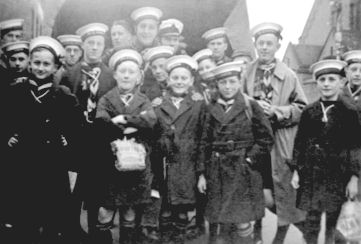 In 1938 the camp was back at Hunstanton with 21 members attending (Seen left, ready to leave for camp - Click the image for more). The camp subscription was not increased - in fact was slightly less for the older
boys - and yielded a total of £24. This time the party traveled by lorry costing only £10 which left £14 to spend on food. A profit of 7d (3p) for the
week highlighted a masterpiece of books balancing.
In 1938 the camp was back at Hunstanton with 21 members attending (Seen left, ready to leave for camp - Click the image for more). The camp subscription was not increased - in fact was slightly less for the older
boys - and yielded a total of £24. This time the party traveled by lorry costing only £10 which left £14 to spend on food. A profit of 7d (3p) for the
week highlighted a masterpiece of books balancing.
This, of course, was the year that the Group marked its Tenth Anniversary and to mark the occasion a Service was held at the Parish Church followed by
supper at the Station Road Headquarters and a Camp-fire. The GSM, Father Addison was in the Chair and the County and District were represented by ADC F. M.
Pridmore and DSM J.H. Brooks. A good turnout of Officers, Friends, Scouts and Rovers heard Arthur Smedley speak of the growth of the Scout Movement
from humble beginnings 30 years earlier and of the great personality of B.P. No doubt thinking of the troubles which were developing in Europe at that
time, he spoke of freedom of speech, thought and action which was theirs and which should be respected. The concluding camp-fire included an impromptu
concert party and - as the newspaper put it - 'when the popular songs were started the tonal exuberance of the younger members of the gathering
made the rafters ring'.
Appearing as new members at that time were Gilbert Bywater, Tim Allinson and twins Peter and Ronald Burton.
By this time the Parents' Committee had become more formal and had a 14 strong Committee which met regularly to organise whist drives, jumble sales and
dances to raise funds for the Group. From time to time, they also offered pencils with the name of the Group for sale. The Chairman at that time was
Mr J. Bell who was also the Treasurer, Mr George Peel was Secretary and the Committee was made up of Mrs Allinson, Mr Searle, Mrs Highton, Mrs Pogson,
Mr & Mrs Gaspar, Mr Simmonds, Mr & Mrs Swaby, Mr Burton and Mrs Peel. Arthur Smedley regularly attended their meetings to represent the Officers. Regular
Open Days for parents and friends at the river base were a feature of the late Thirties. Sporting, boating and good food were the ‘order of the day’
and to help things along the Rovers donated a Cup to be competed for by the Patrols. In each of the years 1935 to 1937, this cup was won by Sturdee
Patrol.
 The Camp in 1939 at Penmaenmawr (The site is shown left - click for more) was, of course, held on the eve of the outbreak of War in the following month. Things would, perhaps, never quite be
the same again but 2nd Beeston was in a strong position to weather the transition and difficulties of the war period to emerge, as it turned out, stronger
than ever. But that was the future - for the moment it could reflect on a strong Group of 20 scouts, 30 cubs, 9 rovers, a strong team of 5 officers
and a keen Parents Committee. These numbers included three new scouts, Harry Banner, Gerry Horton and Albert Cutler. Since inception, we have accounted
for - through newspaper reports, camp records and personal memories - some 75 individuals who were scouts and/or rovers in the Group up until the end
of 1939. The names of Ted Thornhill, Les Pritchett, Eric Oldham, Doug and Cliff Steel, Frank Smethurst, Pat Callaghan, John Clarke, Doug Bramley,
Marlow Jnr, and two Blagg brothers have also been mentioned as being members up to that time without appearing in any other account. Their names would
bring the total up to 87. In addition, many of the 30 cubs at that time were to go on to become scouts during the war. There had been sad times too - Ivan
Ebblewhite, one of the founder members, had died following a mastoid infection.
The Camp in 1939 at Penmaenmawr (The site is shown left - click for more) was, of course, held on the eve of the outbreak of War in the following month. Things would, perhaps, never quite be
the same again but 2nd Beeston was in a strong position to weather the transition and difficulties of the war period to emerge, as it turned out, stronger
than ever. But that was the future - for the moment it could reflect on a strong Group of 20 scouts, 30 cubs, 9 rovers, a strong team of 5 officers
and a keen Parents Committee. These numbers included three new scouts, Harry Banner, Gerry Horton and Albert Cutler. Since inception, we have accounted
for - through newspaper reports, camp records and personal memories - some 75 individuals who were scouts and/or rovers in the Group up until the end
of 1939. The names of Ted Thornhill, Les Pritchett, Eric Oldham, Doug and Cliff Steel, Frank Smethurst, Pat Callaghan, John Clarke, Doug Bramley,
Marlow Jnr, and two Blagg brothers have also been mentioned as being members up to that time without appearing in any other account. Their names would
bring the total up to 87. In addition, many of the 30 cubs at that time were to go on to become scouts during the war. There had been sad times too - Ivan
Ebblewhite, one of the founder members, had died following a mastoid infection.
Now, the World was about to be at war and the training that the boys had received was just what the moment demanded.
Click to read the next chapter
or -
Click here to go back to the top of this page
|
 |
 Out of the Harbour (November 1932 - August 1939) - When the 2nd Beeston was first formed, it had been decided by the then Vicar (Fr. Phillips), that the Curate of the day should automatically become the
Group Scout Master. This decision provided the Group with some wise and excellent leadership in these early days. In this way, Fr. Otway's replacement
as Curate, Rev. Arthur Rumball (Pictured left) took up the position on his arrival in Beeston. He was appointed in November 1932 and arrived before Christmas that year.
Fr. Rumball ('Skipper' to the members) came from Attleborough in Norfolk where he had been involved in Scouting so was an excellent choice as
far as 2nd Beeston was concerned. It seems likely that, when choosing the Curate, his scouting experience was an important consideration.
Out of the Harbour (November 1932 - August 1939) - When the 2nd Beeston was first formed, it had been decided by the then Vicar (Fr. Phillips), that the Curate of the day should automatically become the
Group Scout Master. This decision provided the Group with some wise and excellent leadership in these early days. In this way, Fr. Otway's replacement
as Curate, Rev. Arthur Rumball (Pictured left) took up the position on his arrival in Beeston. He was appointed in November 1932 and arrived before Christmas that year.
Fr. Rumball ('Skipper' to the members) came from Attleborough in Norfolk where he had been involved in Scouting so was an excellent choice as
far as 2nd Beeston was concerned. It seems likely that, when choosing the Curate, his scouting experience was an important consideration.

 It was for this camp at Gilwell that Father Rumball had an alteration made to the small marquee - part of the original equipment but a familiar 'land-mark' at
camps well into the 50s. He had an annexe added to the rear wall so that it could accommodate an altar (See right). Holy Communion was celebrated daily during the
camp.
It was for this camp at Gilwell that Father Rumball had an alteration made to the small marquee - part of the original equipment but a familiar 'land-mark' at
camps well into the 50s. He had an annexe added to the rear wall so that it could accommodate an altar (See right). Holy Communion was celebrated daily during the
camp.


